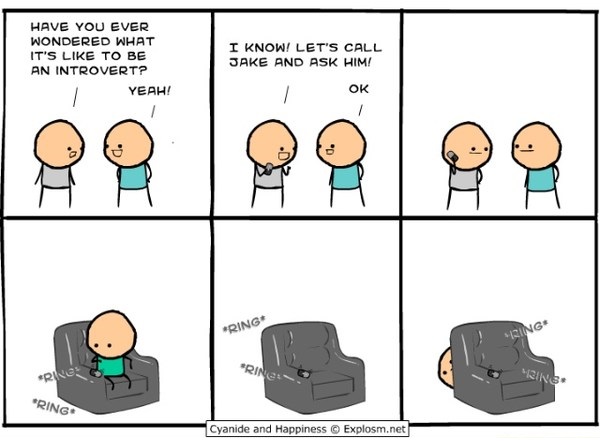Design for introversion
In a culture where being social and outgoing are prized above all else, it can be difficult, even shameful, to be an introvert. But, as Susan Cain argues in this passionate TED talk, introverts bring extraordinary talents and abilities to the world, and should be encouraged and celebrated.
Introversion vs extroversion is a major difference between people. Some people tend to become bored when they are alone and tend to become energized from being around people (extroverts), and others are energized from reflection and drained by being around people (introverts). Introversion and extroversion exist on a spectrum or line rather than a binary one or the other.
I’ll never forget when my friend described coming home from a day of working in the office alone, and how he was anxiously waiting for his room mate to come home so he could talk to him and “get his energy up again”. Say what now? I can’t even imagine what that’s like, so that must make me an introvert. That said, I love talking to interesting people, especially 1-on-1, about ideas and things they are working on, instead of doing small talk or talking about boring stuff like other people doing people-ish things, so I think for an introvert I must be closer to the extrovert end of the spectrum.
The above talk by Susan Cain is worth checking out (interestingly, it received a million views faster than any other TED Talk – and a standing ovation). Susan talks about how introversion tends to be looked down upon, starting with teachers who describe extroverts as the more ideal students. Susan brings up the downfalls of a world that favours extroversion, and suggests accommodating introversion.
I wholeheartedly agree with this idea. The biggest drawback of extroversion is that while it’s great at selling courses of action and generating agreement between people, the ability to generate agreement between people might not support the ‘objectively best’ course of action or decision. Of course, it’s a two way street.
So that’s not to knock extroversion or extroverts, if you ask me extroverts tend to get unfairly pegged as somehow “shallower” people relative to introverts, when that’s not really the case. It’s more about recognizing different modes of behaviour that can be more effective depending on the role one is trying to conduct at a given time. In the case of introversion, that means recognizing that it is sometimes worth accommodating, rather than expecting individuals to overcome introversion.

In many situations, there is a lot of value derived from accommodating introversion. It can allow the better ideas can float to the top, rather than the ideas coming from the most charismatic individual(s). Sometimes it may just not be worth it or realistic, some situations just necessarily require extroverted behaviours, e.g. some forms of sales. But in more technical situations in particular, accommodating introversion can bear worthwhile fruit.
- If you want to gather opinions for a course of action, use surveys or written feedback that give introverts time to process, instead of a discussion.
- If you are going to have a discussion, provide written information ahead of time, introduce pauses in the discussion, and some sort of formal way to order who speaks when, giving everyone a relatively equal opportunity to speak.
- Provide closed workspaces in addition to open workspaces.
- Allow people to work individually unless group work is truly necessary.
- Don’t wait for people to offer ideas, ask for them.
- Don’t interrupt people when they are speaking.
And again, I’d emphasize it’s a two way street. I’m focusing on designing for introversion because our industry is notoriously introverted. If you’re an introvert, you might need to let an extrovert know you need time to think before responding. If you’re the ‘boss’ in a situation you might need to provide opportunities for extroverts to have more free form discussion and to think out loud, etc. Essentially taking the recommendations above and flipping them 180 degrees.
